Hybrid Hazelnuts for Maryland Growers as an Alternative Crop for Maryland Growers
Submitting grant:
David Clement, Extension Specialist in Pathology, HGIC, University of Maryland Extension
Stanton Gill, Extension Specialist in Entomology and IPM, CMREC, University of Maryland Extension, CMREC
Andrew Ristvey, Extension Specialist, Nutrition and Water Management Specialist, Commercial Horticulture, University of Maryland Extension WYE REC
Situation: Maryland growers are in a unique position to produce and market a new crop for local markets. The crop we are proposing can be sold at

farm markets, pick your own, local restaurants and caterer sales and is new to Maryland, is Hybrid hazelnut trees. Disease resistant hazelnuts can be trees that Maryland nurseries can grow and sell to landscapers for installing into landscapes as an edible nut tree.
European hazelnuts, Corylus avellane, produce a high quality nut that can be eaten fresh or used in baked goods. Demand for these nuts are strong and Oregon has been the lead state to produce these nuts for sale in the United States. What has inhibited growth of European type hazelnuts on the East coast has been a devastating disease called filbert blight (Hazelnut=filbert) caused by Eastern Filbert Blight, also known as EFB, a fungal disease that is native to a wide area in eastern North America. Here it is found naturally associated with its host, native American hazelnut (C. americana), on which it causes only limited damage. However, EFB causes severe cankering, branch die-back and death of susceptible European hazelnuts (C. avellana). The primary limiting factor for growth of commercial European hazelnuts is EFB susceptibility.
American filberts, C. americana, are smaller than commercially produced European hazelnuts. That's why the native American species are not usually grown commercially – people prefer the larger European nuts. Wild American hazelnuts are slightly sweeter and milder in flavor but extremely small.
Plant Breeder, Dr. Thomas Molnar, Rutgers University, has released several hybrid cultivars (cross of C. avellane and C. americana) that have the size and shape of European hazelnuts and the filbert blight resistance that American filbert exhibit. He has made these cultivars available through a nursery, Foggy Bottom Plant Nursery, in southern New Jersey. We have contacted both Tom Molnar and the owner of Foggy Bottom Tree Farm, and they have agreed to supply us with filbert blight resistant hybrid hazelnuts to plant at the University of Maryland CMREC facility to evaluate for a new crop for Maryland growers. They will supply two cultivars to evaluate ‘Somerset’ and ‘The Beast’ hazelnut trees, followed by additional cultivars that will available in the fall of 2023.
These plants will be tissue-culture produced plants which will be purchased in May of 2023 and grow in containers until September of 2023. They will then be planted at the Central Maryland Research and Education Center in fall of 2023.
In the fall of 2023, Foggy Bottom Nursery agrees to sell us three additional hybrid, disease resistant hazelnuts from the Rutgers breeding program. These will include ‘Hunterdon’, ‘Grand Transverse’ and ‘Raritan.
What has been done so far in 2023:
We purchased two cultivars of hybrid hazelnuts, ‘Somerset’ and ‘The Beast’ from Foggy Bottom Tree Farm in May of 2023. These were planted in transplanted field research plots at CMREC and WYE REC in June of 2023.
In the fall, additional hybrid filbert plants, ‘Hunterdon’, ‘Grand Transverse, and ‘Raritan’ will be purchased from Foggy Bottom Tree Nursery. These will be planted in September of 2023.
David Clement, Stanton Gill, Andrew Ristvey, Suzanne Klick and Sheena O’Donnell, will evaluate growth, disease resistance and insect tolerance. Field days will be held for Maryland Growers, on a yearly basis, to see the test plots at CMREC and demonstrate to them the most viable cultivars.
